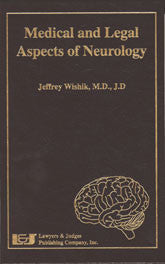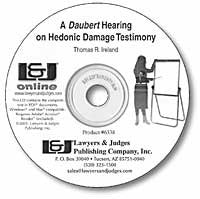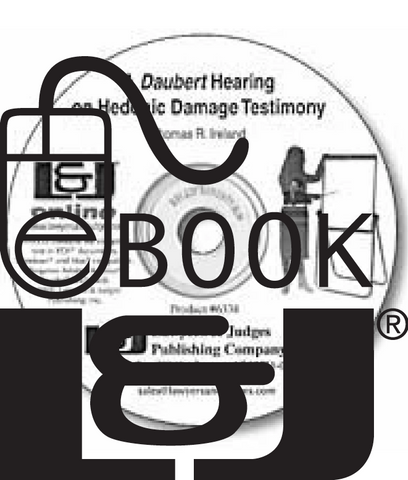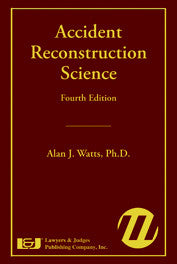
Medical and Legal Aspects of Neurology
- Author: Jeffrey Wishik
- ISBN 10: 1-930056-30-3
- ISBN 13: 978-1-930056-30-5
- Copyright Date Ed: June 15, 2005
- Pages: 346 pages
- Binding Information: Hardcover
- Size: 6 ✕ 9 Inches (US)
In this book, you will find comprehensive coverage of medical tools and explanations that will allow you to understand the way neurological disorders develop. Research in the field, medical illustrations, and recent professional breakthroughs make this book necessary for anyone working in a neurology-related field.
Best of all, the book includes a range of topics so extensive that it provides not only the background for neurological diseases, but also the legal implications that result from unethical action or human error. Medical and Legal Aspects of Neurology covers laws, disorders, and treatments all in one compilation that closely examines the fine aspects of a complicated field. It is with the help of this resource that you can strengthen your case with the broad range of topics and the detailed explanations of each. Working without this tool limits your capabilities to be the best informed on the subject of neurology and its legal implications.
This book is also available as an E-book. Click here to purchase and download:
Table of Contents
Chapter 1: Introduction: Neurology and Neurologists
1.1 The Specialty of Neurology
1.2 The Making of a Neurologist
A. College and medical school
B. Neurology training
C. Subspecialties
1.3 Recognition of Competency: Certification
A. American Board of Psychiatry and Neurology (ABPN)
B. Other certifications
1.4 Professional Organizations
A. American Academy of Neurology (AAN)
B. American Neurological Association (ANA)
C. American Clinical Neurophysiology Society (ACNS)
D. American Headache Society (AHS)
E. American Association of Neuromuscular & Electro-diagnostic Medicine (AANEM)
1.5 Practice Standards and Guidelines
1.6 The Literature of Neurology
A. Learned treatises
B. Journals
Chapter 2:
The Diagnostic Process2.1 Introduction
2.2 General Organization of the Nervous System
2.3 Localization and Diagnosis
2.4 The Neurologic History
Chapter 3:
Diagnostic Testing3.1 Introduction
3.2 Imaging
A. X-ray
B. Computerized tomography (CT)
C. Magnetic resonance imaging (MRI)
D. Angiography
E. Myelography
F. Functional neuroimaging
3.3 Clinical Neurophysiolog
A. EEG (electroencephalogram)
B. EMG (electromyography) and NCS (nerve conduction studies): Uses and limitations
C. Evoked potential (EP) studies
3.4 Lumbar Puncture
A. Postlumbar puncture headache
B. Other complications of lumbar puncture
3.5 Biopsies
3.6 Neuropsychology
Chapter 4:
Sensory and Motor Function4.1 Sensory System
A. Peripheral receptors
B. Transmission to the brain
C. Central processing
D. Sensory examination
E. Interpretation of sensory symptoms and signs
F. Sensory syndromes by location
4.2 Central Control of Movement
A. Pathways to the periphery
B. Motor examination
C. Motor abnormalities
4.3 The Cerebellum and Coordination
Chapter 5:
Cranial Nerves: Organization, Function and Examination5.1 Introduction
5.2 Olfactory Nerve (CNI)
5.3 Optic Nerve (CNII)
5.4 Oculomotor, Trochlear, and Abducens Nerves (CN III, IV, and VI)
5.5 Trigeminal Nerve (CN V)
5.6 Facial Nerve (CN VII)
5.7 Vestibulocochlear Nerve (CN VIII)
5.8 Glossopharyngeal Nerve (CN IX)
5.9 Vagus Nerve (CN X)
5.10 Spinal Accessory Nerve (CN XI)14
5.11 Hypoglossal Nerve (CN XII)
Chapter 6:
Brain and Higher Cortical Function6.1 Basic Organization of the Brain
6.2 Evaluation of Cortical Function
6.3 Coma and Brain Death
A. Coma
B. Brain death
6.4 Language Disorders-Aphasias
A. Broca's aphasia
B. Wernicke's aphasia
C. Conduction aphasia
D. Transcortical aphasia
E. Other syndromes
6.5 Memory and Amnesias
A. Memory
B. Amnesias
6.6 Apraxia and Agnosia
Chapter 7:
Chronic Pain, Somatization, and Symptom Magnification7.1 Introduction
7.2 Pain Assessment
A. Fundamentals
B. Pain assessment tools
C. Impairment ratings for pain
7.3 Pain Classification
A. Acute and chronic pain
B. Chronic neuropathic pain
7.4 Chronic Pain Syndrome (CPS): Nonorganic Pain
7.5 Somatization
A. Factitious disorders and malingering
B. Somatoform disorders
7.6 Assessing Symptom Magnification
7.7 Legal and Regulatory Aspects of Pain Management
Chapter 8:
Traumatic Brain Injury8.1 Introduction
8.2 Assessment of Severity
8.3 Injury Mechanisms
8.4 Consequences of TBI
A. DAI and coma
B. Focal brain damage
C. Epilepsy
D. Hydrocephalus
E. Hematomas
F. Cranial nerve lesions
8.5 Mild Head Injury and Postconcussion Syndrome
Chapter 9:
Spine and Nerve Root Disorders9.1 Introduction
9.2 Low-Back and Neck Pain
A. Acute neck and low-back pain
B. Chronic neck and low-back pain
9.3 Spinal Cord Injury
A. Background
B. Acute management
C. Rehabilitation considerations
9.4 Spinal Spondylosis and Disk Disease
9.5 Whiplash
Chapter 10:
Peripheral Neuropathy10.1 Introduction
A. Classification of neuropathies
B. Evaluation
10.2 Peripheral Nerve Trauma
A. Mechanisms of damage
B. Double crush syndrome
10.3 Carpal Tunnel Syndrome
10.4 Other Mononeuropathies
A. Upper limb
B. Lower limb
10.5 Brachial Plexus Abnormalities
A. Anatomy
B. Brachial plexopathies
C. Thoracic outlet syndrome
10.6 Other Acquired Neuropathies
A. Acute acquired neuropathies
B. Subacute acquired neuropathies
C. Chronic acquired neuropathies
10.7 Inherited Neuropathies
Chapter 11:
Seizures and Epilepsy11.1 Background
11.2 Diagnosis
11.3 Nonepileptic Seizures
A. Physiologic nonepileptic paroxysmal disorders
B. Psychogenic nonepileptic paroxysmal disorders
11.4 Seizure Types
A. Partial seizures
B. Generalized seizures
11.5 Epilepsy Syndromes
A. Localization-related epilepsies
B. Generalized epilepsies
11.6 Epilepsy Treatment
A. General considerations
B. Pregnancy and epilepsy
C. Surgical treatment
11.7 Sudden Unexpected Death in Epilepsy Patients (SUDEP)
11.8 Epilepsy and the Law
A. Driving
B. Aggression, criminal acts, and the epilepsy defense
Chapter 12:
Stroke and Other Cerebrovascular Diseases12.1 Introduction
12.2 Transient Ischemic Attack (TIA)
A. Manifestations <br >B. Causation
C. Evaluation
D. Management
12.3 Stroke
A. Clinical manifestations
B. Initial management
C. Thrombolysis: Medical and legal aspects
12.4 Subarachnoid Hemorrhage (SAH)
12.5 Cerebral Venous Thrombosis
12.6 Temporal (Giant Cell) Arteritis
Chapter 13:
Multiple Sclerosis and Demyelinating Diseases13.1 Introduction
13.2 Generalized Multiple Sclerosis (MS)
A. Trauma, stress, vaccines, and multiple sclerosis
B. Clinical manifestations
C. Course and prognosis
D. Diagnosis
E. Treatment
13.3 Isolated Demyelinating Syndromes
A. Optic neuritis
B. Transverse myelitis
C. Neuromyelitis optica (Devic's disease)
13.4 Other Demyelinating Syndromes
Chapter 14:
Brain and Spinal Cord Tumors14.1 Introduction
14.2 Clinical Presentations
14.3 Basics of Treatment
14.4 Primary Intracranial Tumors
A. Gliomas
B. Meningiomas
C. Primary central nervous system lymphoma (PCNSL)
D. Acoustic neuromas (vestibular schwannomas)
E. Pituitary tumors
14.5 Metastatic Brain Tumors
14.6 Paraneoplastic Syndromes
14.7 Spinal Tumors
A. Background
B. Epidural metastases
Chapter 15:
Headache15.1 Introduction
15.2 Migraine
15.3 Cluster Headaches
15.4 Tension-type Headaches
15.5 Cervicogenic Headache
15.6 Pseudotumor Cerebri (Benign Intracranial Hypertension)
Chapter 16:
Infectious Diseases16.1 Introduction
16.2 Acute Meningitis
A. Pneumococcal meningitis
B. Meningococcal meningitis
C. Haemophilus influenzae meningitis
16.3 Chronic Meningitis
16.4 Syphilis and Lyme Disease
A. Neurosyphilis
B. Lyme neuroborreliosis (LNB)
16.5 Brain Abscess
16.6 Acute Viral Encephalitis
16.7 Human Immunodeficiency Virus
16.8 Prion Diseases
Chapter 17:
Neuromuscular Diseases17.1 Muscle Diseases
A. Inherited myopathies
B. Acquired myopathies
17.2 Neuromuscular Junction Diseases
A. Myasthenia gravis (MG)
B. Lambert-Eaton myasthenic syndrome (LEMS)
17.3 Motor Neuron Diseases
A. Amyotrophic lateral sclerosis (Lou Gehrig's disease)
B. Spinal muscular atrophies (SMA)
C. Acute poliomyelitis and postpolio syndrome
Chapter 18:
Dementias18.1 Introduction
A. Evaluation
B. Mild cognitive impairment (MCI)
C. Cortical and subcortical dementias
18.2 Alzheimer's Disease (AD)
18.3 Vascular Dementia
18.4 Frontotemporal Dementia
18.5 Dementia with Lewy Bodies (DLB)
18.6 Legal and Ethical Implications
Chapter 19:
Movement Disorders19.1 Introduction
19.2 Parkinson's Disease (PD)
19.3 Parkinsonism-Plus Syndromes
19.4 Hyperkinetic Disorders
A. Dystonia
B. Chorea
C. Tremor
D. Myoclonus
E. Tics
19.5 Psychogenic Movement Disorders
19.6 Posttraumatic Movement Disorders: Legal Implications
Chapter 20:
Attention Deficit Hyperactivity Disorder (ADHD)20.1 Introduction
20.2 Symptoms, Diagnosis, and Comorbidities
20.3 Etiologies and Neurobiology
20.4 Treatment
20.5 Medicolegal Concerns
A. ADHD and criminal law
B. ADHD and education
Chapter 21:
Iatrogenic Disorders21.1 Introduction
21.2 Drug-Induced Neurological Disorders
A. Drug-induced movement disorders
B. Other drug-induced neurologic disorders
21.3 Complications of Vascular Disease Treatment
21.4 Iatrogenic Infections of the Central Nervous System
21.5 Neurologic Side Effects of Radiation Therapy




